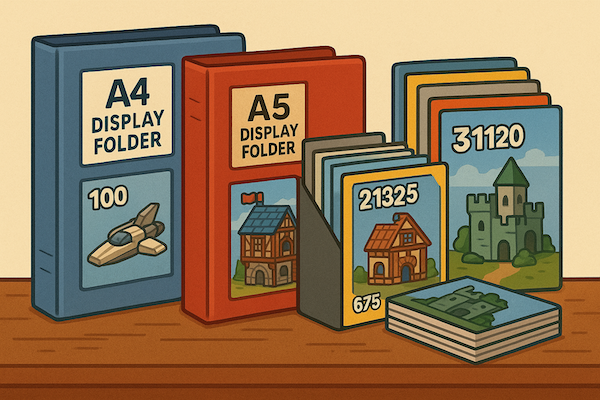
If you’ve been building LEGO for years, or if your collection is growing thanks to recent hauls or childhood rediscoveries, chances are you’ve got a growing pile (or several boxes) of LEGO instruction manuals. These booklets are more than just building guides, they’re collector’s items, design documents, and even mini works of art. Yet, keeping them pristine and accessible can be a challenge.
So how should a serious LEGO collector store, maintain, and organise these manuals? In this post, we’ll look at the best methods, from basic storage ideas to advanced cataloguing systems. We’ll also share a real-world example from Redmond’s Forge, where hundreds of LEGO manuals are meticulously archived by haul and theme, offering a system that blends practicality with storytelling.
Why Instruction Manuals Matter
To some, they’re disposable. To others, they’re just another piece of paper. But for most LEGO collectors and builders, instruction manuals are part of the experience and the value:
- Rebuildability: Want to revisit a favourite set? The manual is your blueprint.
- Resale value: Complete sets with original instructions hold more value.
- Collector satisfaction: Manuals can evoke memories, mark milestones, and offer insight into LEGO’s evolving design language.
- Design inspiration: Looking through manuals can inspire MOCs (My Own Creations) or modifications to existing builds.
1. Storage: Protecting Manuals from Wear and Tear
The first goal is preservation. LEGO instructions, especially older ones, are prone to wear, tearing, and moisture damage. Here are the best ways to physically store them:
A4 and A5 Display Folders
This is the method used at Redmond’s Forge. A4 display folders are used for large instruction manuals (typically from 18+ sets or modular buildings), while A5 display folders are ideal for smaller booklets (City, Friends, polybags, or 4+ sets).
Pros:
- Easy to flip through
- Keeps manuals flat and clean
- Portable and tidy
- Allows for clear labelling
Tip: Use acid-free sleeves or archival quality pockets if you’re aiming for long-term preservation.
Magazine Boxes or Binders
For those who prefer a more modular setup, magazine files can be useful. Store each manual in a plastic sleeve or zip-lock bag before placing it upright.
Pros:
- Easy to file and retrieve
- Stackable
- Good for deep storage
Filing Cabinets or Drawers
Particularly if you have hundreds or even thousands of manuals, a labelled drawer system (like IKEA Alex drawers or office filing cabinets) can provide excellent long-term storage.
Pros:
- High capacity
- Can separate by size, theme, or age
- Easy to protect from light and dust
Digital Backup
Scanning or downloading PDF copies of your manuals (available from LEGO.com) is a great safeguard. Use an app like Brickset, Rebrickable, or BrickLink Studio to link the physical manuals to a digital collection.
Pros:
- Prevents loss from damage or misplacement
- Useful for digital building or mobile reference
- Saves space
2. Organisation: Turning Chaos into Catalogue
Once your manuals are protected, the next step is organisation. There’s no single correct way, but the best systems are both functional and personal.
By Set Number
Ordering by LEGO set number is the most precise and logical method. It makes cross-referencing easy when rebuilding or checking against databases like Brickset.
At Redmond’s Forge, all manuals, whether from hauls or new purchases, are ordered by set number first, with a caveat (needs the by theme also).
By Theme
Grouping by theme (e.g., Star Wars, City, Ninjago, Icons) adds clarity and is especially useful for curating builds in a LEGO room or LEGO museum, then by set number.
In the Forge system:
- Manuals from hauls are grouped by haul, then theme, then set number.
- Manuals from personal purchases are grouped by theme directly, then set number.
This double-layer approach allows the origin story of the set (haul vs. purchased) to be preserved, while still maintaining structure.
By Haul
For those involved in second-hand buying or LEGO hunting, keeping manuals grouped by the specific haul can add a layer of storytelling. At Redmond’s Forge, each haul, whether from Castleknock or Rathfarnham, is recorded, with manuals grouped and stored together in one folder, sometimes with a photo or haul log included.
Why this works:
- You preserve the narrative behind your collection
- You avoid fragmenting sets from bulk buys
- It helps identify duplicates, rebuild opportunities, and gaps in collections
3. Maintenance: Keeping Your Manuals in Top Shape
Avoid Folding or Rolling
Keep manuals flat at all times. Rolled or folded instructions are difficult to flatten without damaging them.
Keep Away from Sunlight
UV light will fade covers and ink. Store your folders or files in a shaded room or drawer.
Climate Control
Like books, instruction manuals are sensitive to humidity. Keep them dry to avoid curling, mould, or ink bleed.
Label Your Folders
Whether you’re using display folders or binders, labels are essential. You could go for:
- “2025 Hauls – Ninjago + Star Wars”
- “Purchased Sets – LEGO Ideas (Set 21300–21350)”
- “Castleknock Collection – Mixed Themes”
Consistent labelling makes browsing fun and useful.
4. Cataloguing: Digital Integration and Inventory Management
As your collection grows, a digital record can help you stay organised. Consider:
Brickset / Rebrickable
Both platforms allow you to track owned sets, wanted sets, and parts. You can often upload photos or notes about instruction manual condition.
Spreadsheets
For total control, create a Google Sheet or Notion database with the following fields:
- Set Number
- Theme
- Year
- Manual Condition
- Stored In (e.g., “A4 Folder 3 – Castleknock”)
- Haul Origin
- Notes
QR Codes
For advanced collectors, add a QR code sticker inside your folder. When scanned, it opens a digital folder with:
- PDF manual
- Photos of the build
- Notes about display or play
Final Thoughts: From Manuals to Memories
Instruction manuals are more than paperwork, they’re a living archive of your LEGO journey. Whether you’re just starting or have thousands of sets, creating a well-maintained, themed, and personal storage system adds depth to your collection.
At Redmond’s Forge, the approach is part archival, part storytelling. Every haul tells a story. Every display folder is a chapter. And every manual becomes a memory waiting to be revisited, rebuilt, or reimagined.
So the next time you’re tempted to toss that instruction booklet in a drawer, or worse out, pause. File it. Label it. Treasure it. Because in the world of LEGO, even the paper builds part of the magic.

